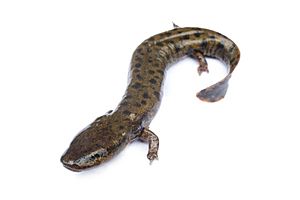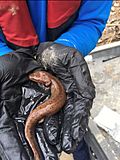Necturus facts for kids
Quick facts for kids Necturus |
|
|---|---|
 |
|
| A common mudpuppy (Necturus maculosus) | |
| Scientific classification |
|
| Kingdom: | Animalia |
| Phylum: | Chordata |
| Class: | Amphibia |
| Order: | Urodela |
| Family: | Proteidae |
| Genus: | Necturus Rafinesque, 1819 |
| Species | |
|
Eight species (but see text) |
|
| Synonyms | |
|
|
Necturus is a group of amazing salamanders that live only in water. They belong to the family called Proteidae. You can find these cool creatures in the eastern United States and Canada. People often call them waterdogs or mudpuppies.
The common mudpuppy (N. maculosus) is probably the most famous type. It's an amphibian that has special gill slits, which help it breathe underwater. This salamander is found across a wide area in North America.
Contents
Understanding Necturus: Taxonomy
Scientists who study amphibians and reptiles, called herpetologists, are still learning a lot about Necturus. They are trying to figure out how all the different species are related to each other.
For example, in 1991, a scientist named Collins suggested that N. maculosus louisianensis should be its own species, N. louisianensis. Even though it was first described as a species, it was often thought of as just a subspecies (a smaller group within a species). Later, in 2018, another study agreed that it is indeed a separate species.
Types of Necturus: Species
There are currently seven or eight known species of Necturus. Here are some of them:
| Image | Scientific name | Common Name | Where they live |
|---|---|---|---|
 |
Necturus alabamensis Viosca, 1937 |
Alabama waterdog | Only in Alabama. |
 |
Necturus beyeri Viosca, 1937 synonym: N. lodingi Viosca, 1937 |
western waterdog (also called Gulf Coast waterdog) or Mobile mudpuppy. | Found in Alabama, Louisiana, Mississippi, and Texas. |
 |
Necturus lewisi Brimley, 1924 | Neuse River waterdog | Lives in North Carolina. |
 |
Necturus louisianensis Viosca, 1938 |
Red River waterdog. | Found in southeastern Kansas, southern Missouri, northeastern Oklahoma, Arkansas, and north-central Louisiana. |
 |
Necturus maculosus (Rafinesque, 1818) | common mudpuppy | Lives in the southern part of Canada, and as far south as Georgia in the U.S. |
 |
Necturus moleri Guyer et al., 2020 |
Apalachicola waterdog | Found in southeastern Alabama, the Panhandle of Florida, and southwestern to north-central Georgia. |
| Necturus mounti Guyer et al., 2020 | Escambia waterdog | Lives in southern Alabama and the Panhandle of Florida. | |
| Necturus punctatus (Gibbes, 1850) | dwarf waterdog | Found from southeastern Virginia to south-central Georgia. |
Sometimes, the name of the scientist who first described a species is in parentheses. This means the species was originally placed in a different group (genus) than Necturus.
Scientists have also found two types of fossil Necturus. One, called N. krausei, was found in Saskatchewan and dates back to the Paleocene era. Another unnamed species was found in Florida from the Pleistocene era.
Physical Features: Description
Necturus salamanders are special because they are paedomorphic. This means that even as adults, they keep some features that young salamanders usually have. For example, they have external gills (bushy red parts on their heads) and no eyelids.
They are fairly strong salamanders with two pairs of short, well-developed legs. They also have a large tail that is flat on the sides, which helps them swim. They do have small lungs, but they mostly breathe through their gills and skin.
Most adult Necturus are about 20 to 25 centimeters (8 to 10 inches) long. However, the common mudpuppy (N. maculosus) can grow much larger, sometimes reaching up to 40 centimeters (16 inches)!
The common mudpuppy usually has a brown or gray back with bluish-black spots. Its belly might have spots, or it might not. They have bright, dark red, bushy gills. Each of their back legs has four toes.
Life Cycle: Reproduction
Female Necturus lay their eggs in late spring and early summer. They carefully place their eggs under rocks or other large objects in the water. The mothers guard their nests until the eggs hatch.
Even while guarding their eggs, females will go out to find food. Sometimes, if there isn't enough other food, they might even eat some of their own eggs to get energy. Young salamanders are thought to stay hidden under the rocks until as late as November.
Where They Live and What They Eat: Ecology
Necturus salamanders prefer to live in clear water with rocky bottoms, where there isn't much mud or silt. The common mudpuppy (N. maculosus) can be found in lakes, rivers, streams, and creeks. They like shallow water that stays cool, especially from autumn to early spring.
These salamanders are most active when the water is cold, usually between 9.1 and 20.2 degrees Celsius (about 48 to 68 degrees Fahrenheit). During the day, N. maculosus hides under rocks, logs, or plants. At night, they come out to hunt for food. They love to eat crayfish! In the winter and spring, they will also eat fish.
N. maculosus are important because they can tell us how healthy an ecosystem is. If these salamanders are doing well, it often means the water and environment are clean. Sadly, they can be harmed by accidental fishing, pollution from chemicals, and too much silt in the water. A fungus called amphibian chytrid fungus (Bd) has affected mudpuppies in captivity, but scientists are still studying if it affects them in the wild.
See also
 In Spanish: Necturus para niños
In Spanish: Necturus para niños

